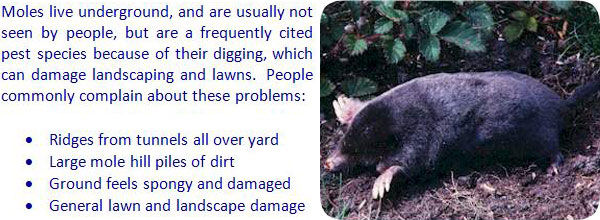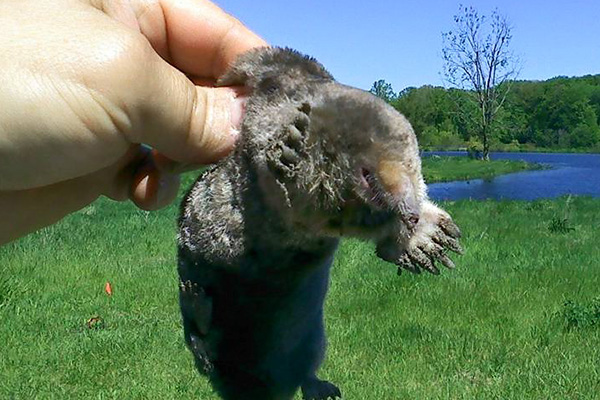- info@wildlifeanimalcontrol.com
Call us for help in your town
Wildlife Control Education
About Moles: Biology, life cycle, habitat, diet

Moles are very small mammals which are basically belonging to the class of rodents. These mammals are strongly related to rats and mice in appearance and somewhat in lifestyle as well. Basically the moles have got a subterranean kind of lifestyle. We can also say that they are fossorial in their habit and habitat.
Appearance and Biology of moles : The general appearance of moles such that their body is cylindrical in shape and they have got a thick velvety fur on their bodies! The body of the mole is so fat that the vital organs like ears and eyes appear to be very inconspicuous and small. Similarly the hind limbs are also reduced and are not of much bigger size. However the fore limbs of moles are especially evolved for the purpose of digging. They have very strong paws on their fore limbs. The true moles are belonging to the family Talpidae and occurrence of this animal is mostly in the continent of North America. Apart from that moles are also found in many areas of Asia and Europe. There are also some animals found in Australia and South Africa which may have the body plan like that of moles but they are not moles in fact.

Diet of moles :
Most commonly the diet of moles is consisting of the earthworms and other small invertebrates which are found in the soil. Basically the moles live in soil that is why they also rely on the creatures and fauna found in the soil. In addition to this, moles also rely on different kinds of nuts as their food. Therefore we can say that moles are not specific in their diet and are omnivores. The mole runs which are dug underground are basically meant to trap the worms. The mole can sense the worm falling into the tunnel and then it runs quickly to eat it up. There is a species of star nosed mole. It has been known to catch and detect the prey with a speed faster than the working and following of a human eye.
Life cycle of moles :
Depending on the species of moles, the breeding season varies. Normally the mating season is form February to May when the male moles search for females and give mating cells in the form of highly pitched squeaking voices. The gestation period of different species of moles varies. For example in case of the Eastern mole, the gestation time is from February to Mau while in the Eastern mole, the gestation time is of one month only. In general 2 to 5 young ones are born at a time.
More in-detail how-to mole removal articles:
Information about mole trapping - analysis and methods for how to trap.
Information about how to kill a mole - with poison or other methods.
Information about how to keep moles away - prevention techniques.
Information about how to catch a mole - remove one stuck in the house.
Information about mole repellent - analysis of types and effectiveness.

















